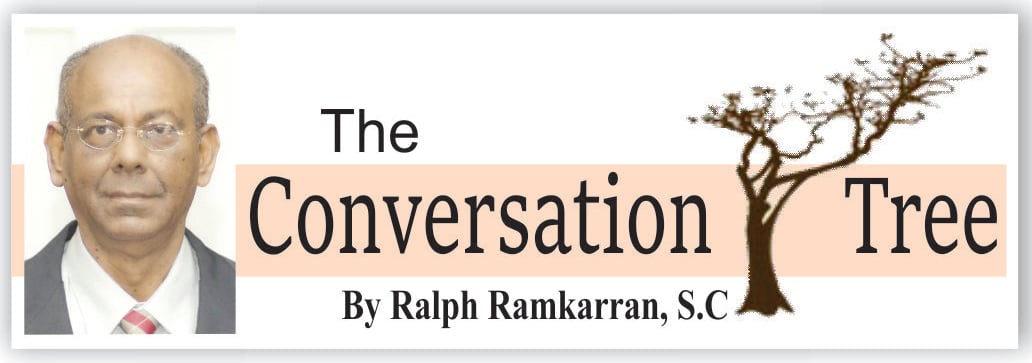D’Urban Park and D’Urban Backlands are named after Sir Benjamin D’Urban, appointed Governor of Demerara-Essequibo in 1824. He became, with the addition of Berbice in 1831, Governor of British Guiana from 1831 to 1833. D’Urban Park was home to Guyana’s most famous horse racing track. I remember when, still a child, I was taken to horse racing there, perhaps in the early 1950s. I don’t know by whom, but I believe that it might have been an uncle, a lifelong horseracing enthusiast. I distinctly recall the crowd and the noise, over which the resonantly distinctive voice of the announcer, expertly modulated and paced to evoke tension and excitement as the race came to a climactic end. That voice announced horse racing over the radio throughout my youth.
The announcer was Lloyd Luckhoo. The family’s love of horses and horse racing transcended the generations. Edward (’Eddie’) Luckhoo, the son of Lloyd, who frequented D’Urban Park during racing season as a schoolboy to take care of horses owned by his father, now himself owns racehorses. If prompted, Eddie, who has great knowledge of D’Urban Park horseracing, will expertly dissect recent horseracing events in the US and elsewhere. As an aside, in later years, starting in the late 1970s and regularly for a little over ten years, I had the privilege of working, sometimes on the same side as, and sometimes on the opposing side to Lloyd Luckhoo, he having by then become a famous lawyer. We were among a small group of lawyers, who represented a small group of clients in a particularly contentious field of civil litigation. That familiar voice of Lloyd Luckhoo continued to ring in my ears as an adult.
Driving to work on Homestretch Avenue several times a week over the past several decades, I felt for D’Urban Park, maybe because of that fleeting childhood memory of its glory days, as it became overrun with haphazardly growing weeds, bushes and wild trees. I have often wondered why it could not be developed as a real park for the citizens of and visitors to Georgetown. It is large enough to accommodate trees and flower patches, a walkway for joggers around all or part of the perimeter, football, cricket, and hockey fields as well as lawn tennis and basketball courts, safe play areas for children, gardens and benches for relaxation, restricted areas for sale of snacks, a car park and other amenities. With its large open space, it can still become an oasis in an increasingly congested city, gradually being overrun by square, concrete structures of no aesthetic value, wild driving, double parking, careless pedestrians, uncouth road users, an infestation of minibuses, blaring horns and rubbish-strewn, pot-holed streets.
The Government changed in 2015 and the new dispensation immediately manifested its character by the hurried and controversial construction at D’Urban Park of an ugly set of wooden structures, purporting to be stands for seating invitees to listen to politicians celebrating Guyana’s 50th Independence Anniversary in 2016. Two areas were already in existence that could have accommodated such events – a refurbished National Park or the Providence Stadium. As time passed, it was realized that the structures at D’Urban Park reflected the low standards that the decades of poor management and distressed condition of the city engendered in the political hierarchy. It precluded the imagination from rising above the pedestrian. After the US Embassy in the 1970s, nothing of unique quality was constructed in the city, even now as demonstrated by the boxes that are the Marriot and Pegasus hotels. And check out the unfinished monstrosity to house the Ministry of Health in Upper Brickdam.
With the decline of Georgetown as the ‘garden city,’ and with it the disappearance of its shaded, tree-lined avenues, darkly glittering waterways, pebbled streets and colonial-style houses, governmental authorities seemed also to have lost any interest in restoring it, even partially. The state of City Hall, which has existed for at least 15 years, tells this sad story. By happenstance, the large space of D’Urban Park still exists, and it is available to create a place of beauty and recreation. At the north-eastern edge of South Georgetown, its residents will benefit enormously from the beautification of that area.
A space in Georgetown that can be similarly developed as a green haven for residents and visitors to the city is the vast real estate abutting Seawall Road. Unless the Government has set it aside for hotels and other high rises to create a skyline for Georgetown and feed the oil industry, which would be deeply regrettable, this area can also be developed for relaxation purposes before vendors take up permanent residence and cannot be removed, as at the airport. It has always been so used by Georgetown residents for vastly more than fifty years.
For those of us who live and work in the city, it will become ‘old’ Georgetown. As a few rare voices seek to make it more habitable, ‘new’ Georgetown will be taking shape at the periphery of the ‘old,’ which will awe and overwhelm with its glittering mansions and high-rise office buildings. We need to raise our voices now for ‘old’ Georgetown to make living in it a pleasurable experience, and as ‘new’ Georgetown takes shape, in a petroleum-fuelled frenzy, discarding standards.
This column is reproduced, with permission, from Ralph Ramkarran’s blog, www.conversationtree.gy










